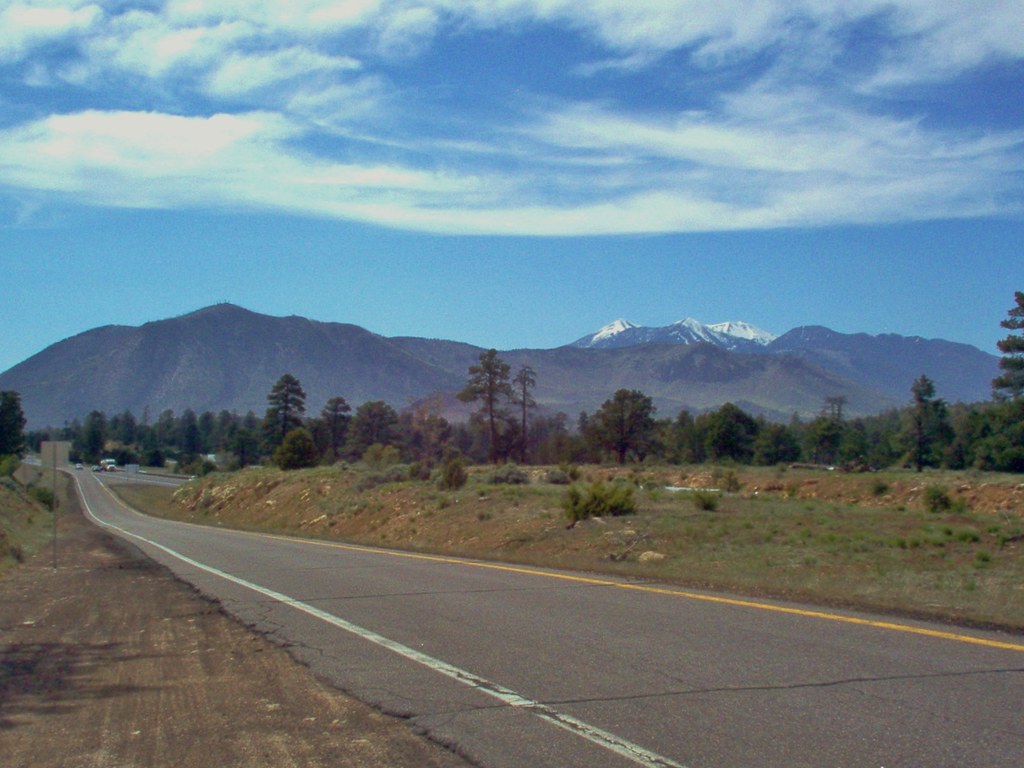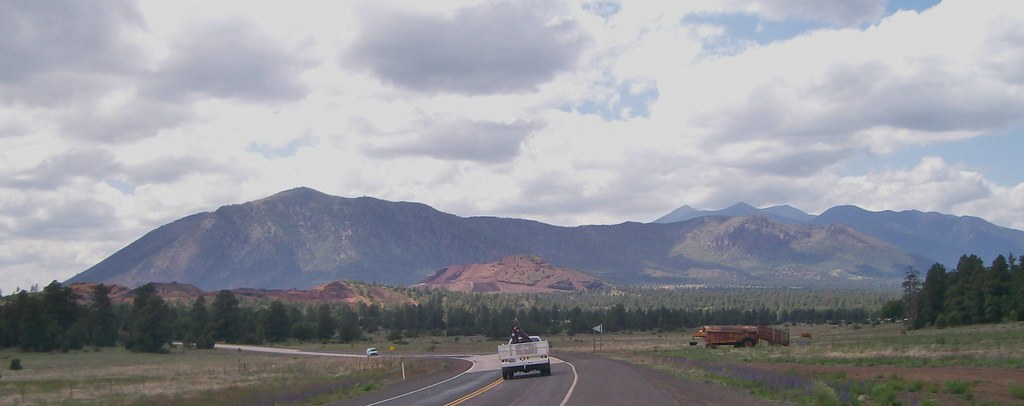 |
| Mount Elden from Route 66 (San Francisco Peaks in background). May 20th, 2005 |
Funny how you can spend so much time staring out the window at something less than a quarter mile away, not to mention climb it, and have no real idea what the hell it is.
The teachers mostly didn't mention Mount Elden. It was just there, this great big brown lump, unremarkable in every way aside from the fact it was a volcano in the midst of a city. Once a year or so, they'd herd us all into the gym and roll out the film projector, and Mount Elden would get its fifteen minutes of fame in an old video showing us what happens when runaway kiddies light campfires in canyons on a mountain in dry country. The results were probably a bit reminiscent of when it erupted: lots of smoke and sparks and a terrifying orange glow that seemed like it would consume the world. They thought they'd lose the city before they got the fire out, and the scars are still there. Trees don't grow back well on steep lava slopes in dry country. Erosion undoes what our precious little water tries to do. The mountain may not recover until the climate changes. So, children, look upon Mount Elden and know why you should never, ever light a match.
Somehow, some way, we learned it was a volcano, which led to a few nervous moments until we were told it's not merely dormant, but extinct. Extinct was good. Except, of course, on those days when it was sunny and brilliant outside and it might have been nice to have a merely dormant volcano fast becoming active outside so they'd have to evacuate us.
One of our teachers pointed to it as a prime example of a shield volcano, and for years, I thought that's what it was. Big lump of near-solid lava, what else could it be?
2,300 feet worth of dacite dome, is what. Five or six hundred thousand years ago, thick, sticky magma that occupies that space on the continuum between andesite and rhyolite squeezed up through the old sedimentary layers, overturned them, and extruded itself out in globs and lobes until it built a mountain. As it erupted, bits cooled, fractured in the process, and peppered the slopes with boulders. Lava flows on those steep slopes sometimes lost their hold and became chaotic avalanches of hot gas and chunks of dacite that fanned out around the base of the volcano. The rest of it piled into mounds and cliffs, incredibly steep, where a few rare resident bald eagles live.
 |
| Elden's Cliffs, where the bald eagles dwell. June 10, 2009 |
 |
| Mount Elden, seen from Sunset Crater. June 10, 2009 |
The mountain has human stories to tell. About a little girl lost who nearly fried the city, and a little boy, whose family homesteaded on the flanks of the mountain over a hundred years ago. There was a spring there, and water was precious. There wasn't much of it. And when the homesteaders had to make the choice between watering their herds and family and watering a passing stranger's mules, they chose to refuse the gift of water. There was, after all, another spring not far away, with more water more easily spared. The stranger, not happy with this reply, fired at the family, and killed their young son. Being a little girl myself, standing in that meadow where water trickled through an old pipe, looking at the site where a home used to stand and a family had been forced to bury their child, I felt the tragedy of it acutely.
You can still see his grave. And the mountain carries his family name, so it, too, stands as something of a memorial.
Mount Elden stands as a reminder of acts that cannot be undone. With the strike of a match, the firing of a gun, something can be taken away that can never be replaced.
And that, combined with the fascination of its geology - I mean, a young dacite dome far from a plate boundary? - transforms it from an odd lump of lava into something truly beautiful.
 |
| Mount Elden from Route 66, photographed by my Intrepid Companion. June 11th, 2009. The chewed-up pile of cinders in front of it is the remnant of a cinder cone, now a quarry. |







1 comment:
Trees don't grow back well on steep lava slopes in dry country.
At higher altitudes, they don't grow back all that easily in the Pacific Northwest, where there's usually no shortage of rain. There's not much dirt, and so there's not much moisture. So it's little wonder you saw those problems in that high desert.
Post a Comment